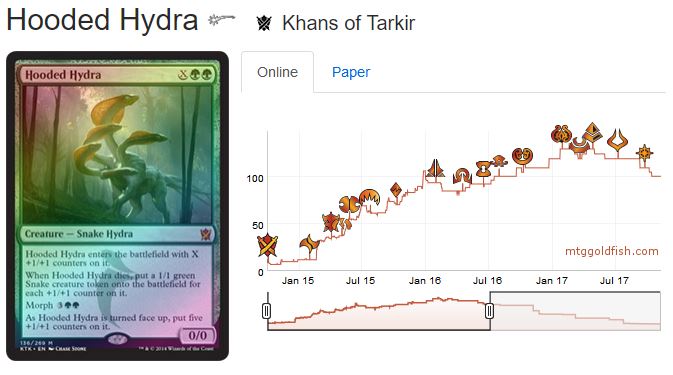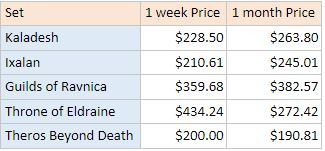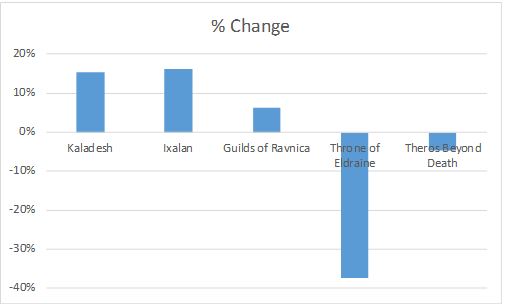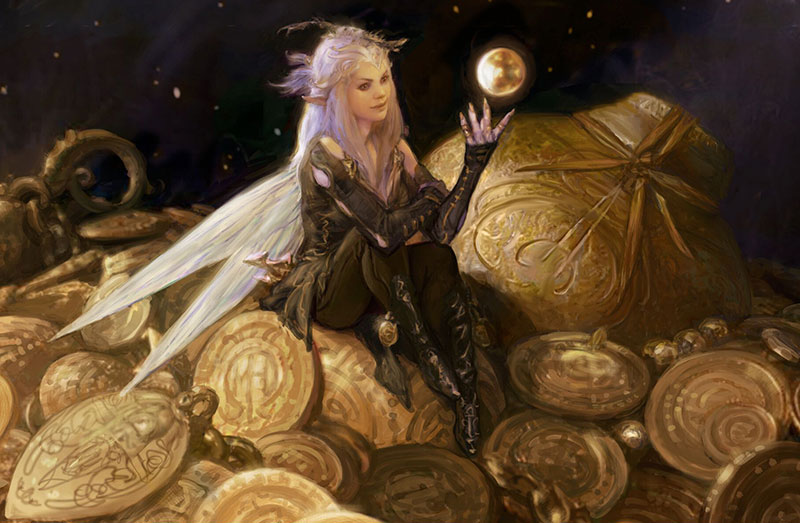Are you a Quiet Speculation member?
If not, now is a perfect time to join up! Our powerful tools, breaking-news analysis, and exclusive Discord channel will make sure you stay up to date and ahead of the curve.
Welcome back, folks. I hope everyone is hanging in there and staying safe and sane during this difficult time. Today I'd like to discuss what once was a solid safe investing strategy in MTGO finance -- buying foil mythics from the most recently released set -- and why that strategy is no longer viable.
I. What was the Foil Mythic Strategy?
Historically, MTGO Redemption has been one of the primary ways that foils have entered the paper market. Paper stores, investors, and collectors have often gotten their foils by redeeming foil sets from Magic Online. It has been broadly cheaper to get foils this way, and you can redeem foil sets between four and fifteen weeks after a set has been released.
To capitalize on this demand for foils from MTGO Redemption, savvy investors would buy foil mythics during the first few weeks of a set's release before it was possible to redeem a set. Then, once redemption went live and demand for these foils spiked, these investors would sell them to meet the higher demand, at a higher price point. This increased demand led to broadly higher prices, and even led to some obscene prices for foil mythics that were opened less than the others.

Remember me?
To highlight this, I've gathered data from aggregate foil prices from the past several Fall sets and Theros Beyond Death during the first month of release. Because most positive movement came from foil mythics, the gains possible were greater than a cursory look might suggest. Prices are taken roughly 1 week after release and then roughly 1 month after release of each set.


As we can see, the foil landscape has changed. Foil prices used to increase modestly (and almost all of that growth came from foil mythics, so targeting foil mythics would have seen higher growth). But beginning with Throne of Eldraine, foil mythic prices on MTGO no longer followed the pattern that they had for so many years. The reason for the change is that Wizards began pumping more foils directly into the paper market through their Standard booster products. Foils have become more common, and therefore the paper market no longer relies as heavily on MTGO to supply it with foils. And as the price of paper foils has gone down in response to their increase in supply, foils on MTGO have lost the premium that was bound up in their redemptive value. There is still healthy demand for redeeming foils on MTGO, but investors can no longer count on foil prices far exceeding the value of non-foil versions.
II. Wizards Shifts Its Target Audience in Paper
Many see the mythic editions and collector boosters as a reworking of the masterpiece series from the Battle for Zendikar and Kaladesh era. I don't believe that this is exactly the case. The masterpiece series created a highly desirable collectible class of card that, because they were included in ordinary booster packs, would cause more booster boxes to be sold. The goal of the masterpiece series was not only to generate revenue by tapping into collectors' demand for rare and aesthetically unique cards, but also to lower the price barrier of entry into Standard for players by increasing the supply of regular versions of cards. The masterpiece series was, therefore, created with both the player and the collector in mind.
Collector Boosters, like the Mythic Editions they replaced, do not share the same goals as the masterpiece series. Because Collector Boosters are a standalone product, they do not balloon the amount of regular cards in circulation and thus do not make Standard more accessible or affordable for a paper audience. The goal of Collector Boosters is to maximize the amount of money paid per Standard card by creating premium exclusive desirable versions of Standard cards. Unlike the Masterpiece series which increased revenue by increasing the sheer volume of Standard product sold, Collector Boosters increase generated revenue on a per-card basis (and they do not affect reprint equity because they only special versions of the latest Standard cards). Collector Boosters are therefore created with the player in mind only insofar as that player is himself a collector.
This marks a dramatic shift from previous years, and I suspect the change in focus is due to Magic Arena. Wizards has pushed many Standard and casual players from paper to digital, meaning that collectors, competitive players, and Commander players make up a higher proportion of the paper community than ever before. Collector Boosters, the latest initiative of Project Booster Fun, are a nod to this changing reality of the paper audience.
III. What does this mean for Foils on MTGO?
Mythic redeemable foils on MTGO are having their prices depressed in two ways, both associated with Project Booster Fun. Collector Boosters are the one we've already discussed, and the roughly 50% increase in foil frequency in regular booster packs is the other.
I do not expect foil mythics to regain the currency they once had. Collector Boosters will likely continue for at least the next few sets, if not longer, and I fully expect Wizards to continue down the path of having its digital offerings cater to the player and its paper offerings to cater to the collector. It is possible that the delay in the release of Ikoria in paper due to the Coronavirus may provide some sort of window where foil mythics will regain some of the value they had in previous years, but overall what we've seen with Throne of Eldraine and Theros Beyond Death has become the new normal.
When you open a foil mythic on MTGO in a draft, you should sell it. QS readers wishing to redeem foils on MTGO don't need to plan ahead and buy their foils ahead of time -- they can simply redeem foil sets when they like (though we are seeing now that waiting is generally a good idea, as prices seem to trend downwards over time as collector booster supply enters the market).
The other main piece of advice I have is that these Collector Booster versions (many of which are not foil) have ballooned the number of different versions individual cards have on MTGO. This is a great boon for investors because you can buy and sell playsets of each version all at once. I have now begun taking this fact into consideration when deciding which cards I want to invest in, and I think it is something that others should begin considering too.
IV. Signing Off
As I write this, I have already begun a market update article. Prices on MTGO continue to do well, and COVID-19 has only redoubled upward pressure on card prices that we have seen over the past six months. So expect to see that article in the next few days, along with some investment advice to take advantage of the current state of the MTGO marketplace. If you have any questions about foils on MTGO, or have anything to add to this discussion, do leave a comment down below or message me on Discord. Thanks!






Great article. Well thought out and well written.
Thank you David, appreciate it
Any idea why foils are in fact worth less than their non-foil counterparts? For example uro trades at about 45tix while foil uro is only worth about 34.